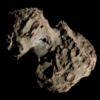astro.wikisort.org - Comet
332P/Ikeya–Murakami (P/2010 V1) is a short-period comet with period of approximately 5.4 years[2] first identified independently by the two Japanese amateur astronomers Kaoru Ikeya and Shigeki Murakami on November 3, 2010.[7][8] Ikeya identified the comet using a 25-centimeter (10-inch) reflector at 39×, while Murakami used a 46 cm (18-inch) reflector at 78×.[7] Photographic confirmation of the comet was obtained by Ernesto Guido and Giovanni Sostero using a Global-Rent-a-Scope (GRAS) telescope in New Mexico. Both Ikeya and Murakami discovered the comet using manual observation through optical telescopes. Such visual discoveries have become rare in recent years.[7]
 332P/Ikeya–Murakami photographed by the Hubble Space Telescope in January 2016.[1] | |
| Discovery | |
|---|---|
| Discovered by | Kaoru Ikeya and Shigeki Murakami |
| Discovery date | November 3, 2010 |
| Alternative designations | 2010 V1; 2015 Y2 |
| Orbital characteristics A | |
| Epoch | 2016 Jan. 13[2] |
| Observation arc | 124 days (fragment A)[3] |
| Perihelion | 1.573 AU (q) |
| Eccentricity | 0.4904 |
| Orbital period | 5.42 yr[2] |
| Inclination | 9.387° |
| Last perihelion | 2021-Aug-18 (A)[4] 2016 Mar. 17 (A)[2] 2016 Mar. 17 (B)[5] 2010-Oct-13[2] 2005-May |
| Next perihelion | 2027-Jan-19? (A)[6] |
At the start of November 2010, a few weeks past perihelion passage, it was discovered the comet had undergone a major outburst between October 31 and November 3.[9] After the 2010 perihelion passage, the comet only had about an 80-day observation arc.[9]
The recovery of P/2010 V1 on December 31, 2015, at magnitude 20 was announced on January 2, 2016, and designated as P/2015 Y2.[2] A secondary fragment (B) was confirmed and announced on January 5, 2016.[5] The comet is now composed of component A and B with two different comas, envelopes and tails.[5] Around January 11, 2016, two fainter potential fragments, designated P/2010 V1-C and P/2010 V1-D have been located, both likely having been fragmented from P/2010 V1-B. As of January 29, fragments B and D had nearly entirely disintegrated, and fragment C had undergone an outburst, making it as bright as P/2010 V1-A.
Even fragment A has not been observed since May 2016 and only has a 124 day observation arc.[3]
| Comet fragment | semimajor axis (AU) | perihelion | eccentricity | inclination | M2 | approximate size (m) | ascending node | argument of peri | Discovery date |
|---|---|---|---|---|---|---|---|---|---|
| A | 3.08642 | 1.572883 | 0.49039 | 9.3869 | 19.3 | 470 | 3.7827 | 152.442 | 2016/01/02 |
| B | 3.0834 | 1.57287 | 0.48989 | 9.3824 | 20.8 | 240 | 3.796 | 152.378 | 2016/01/01 |
| C | 3.0894 | 1.57293 | 0.49086 | 9.3870 | 12.5 | 10900 | 3.7810 | 152.430 | 2010/11/03 |
| D | 3.083 | 1.5714 | 0.4904 | 9.379 | 19.5 | 430 | 3.76 | 152.6 | 2016/02/01 |
| E | 3.09 | 1.573 | 0.491 | 9.39 | 22.5 | 110 | 3.8 | 152.5 | 2016/01/18 |
| F | 3.15 | 1.585 | 0.496 | 9.51 | 22.1 | 130 | 3.60 | 152.4 | 2016/02/05 |
| G | 3.06 | 1.551 | 0.494 | 9.27 | 20.6 | 260 | 3.6 | 154.5 | 2016/02/10 |
| H | 3.0860 | 1.57283 | 0.49033 | 9.3857 | 18.9 | 570 | 3.786 | 152.421 | 2016/02/05 |
| I | 3.083 | 1.5730 | 0.490 | 9.38 | 21.7 | 160 | 3.80 | 152.4 | 2016/02/05 |
References
- "Cosmic Fragments". www.spacetelescope.org. Retrieved 20 September 2016.
- "MPEC 2016-A10 : COMET P/2010 V1 = 2015 Y2 (Ikeya-Murakami)". IAU Minor Planet Center. 2016-01-02. Retrieved 2016-01-12. (PK15Y020)
- "JPL Small-Body Database Browser: 332P/Ikeya-Murakami-A" (2016-05-05 last obs). Retrieved 2021-09-17.
- "332P/Ikeya-Murakami Orbit". Minor Planet Center. Retrieved 2017-04-10.
- "COMET P/2015 Y2 (IKEYA-MURAKAMI)". Central Bureau for Astronomical Telegrams. 2016-01-05.
- "Horizons Batch for 332P/Ikeya-Murakami-A (90001260) on 2027-Jan-19?" (Perihelion occurs when rdot flips from negative to positive). JPL Horizons. Retrieved 2021-09-17. (JPL#15 / Soln.date: 2021-Feb-24 / last obs: 2016-05-05)
- Sinnott, Roger (2010-11-04). "New Binocular Comet in the Morning Sky". Sky & Telescope. Archived from the original on 2010-11-10. Retrieved 2010-11-05.
- "Ikeya–Murakami: The New Comet on the Cosmic Block". NASA. November 17, 2010. Retrieved 14 December 2010.
- Ishiguro, Masateru; Jewitt, David; Hanayama, Hidekazu; Usui, Fumihiko; Sekiguchi, Tomohiko; Yanagisawa, Kenshi; Kuroda, Daisuke; Yoshida, Michitoshi; Ohta, Kouji (2014-05-20). "Outbursting Comet P/2010 V1 (Ikeya-Murakami): A Miniature Comet Holmes". The Astrophysical Journal. 787 (1): 55. arXiv:1404.1630. Bibcode:2014ApJ...787...55I. doi:10.1088/0004-637X/787/1/55. ISSN 0004-637X.
External links
- P 2010 V1 IKEYA-MURAKAMI
- 332P/Ikeya-Murakami – Seiichi Yoshida @ aerith.net
Другой контент может иметь иную лицензию. Перед использованием материалов сайта WikiSort.org внимательно изучите правила лицензирования конкретных элементов наполнения сайта.
WikiSort.org - проект по пересортировке и дополнению контента Википедии

